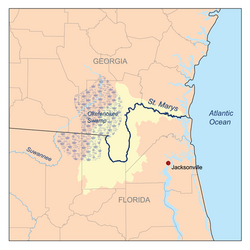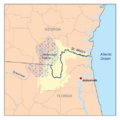Battle of Fort Peter facts for kids
Quick facts for kids Battle of Fort Peter |
|||||||
|---|---|---|---|---|---|---|---|
| Part of War of 1812 | |||||||
 St. Marys River |
|||||||
|
|||||||
| Belligerents | |||||||
| Commanders and leaders | |||||||
| Land: unknown Sea: George Cockburn |
Abraham A. Massias Daniel Newnan |
||||||
| Strength | |||||||
| Land: 1,500 unknown artillery Sea: 1 Third Rate 1 Fourth Rate 4 Fifth Rates 2 bomb ketchs 2 schooners |
Land: 160 8 guns Sea: 2 gunboats |
||||||
| Casualties and losses | |||||||
| 3 killed 5 wounded |
1 killed 4 wounded 9 missing 8 guns captured 2 gunboats captured 12 merchantmen captured |
||||||
The Battle of Fort Point Peter was an attack by British forces on a smaller American force in early 1815. This battle happened on the Georgia side of the St. Marys River, near St. Marys, Georgia. At the time, the river was part of the border between the United States and Spanish Florida, which was allied with Britain. Today, it helps form the border between Georgia and Florida.
By taking control of coastal Camden County, the British could stop American ships from using the Intracoastal Waterway. The attack on Forts St. Tammany and Peter took place in January 1815. This was after the Treaty of Ghent was signed, which officially ended the War of 1812. However, the treaty had not yet been fully approved, so fighting continued. This attack was part of a larger British plan to occupy St. Marys and Cumberland Island.
Contents
Forts at St. Marys
Point Peter is the first place ships could land on the Georgia side of the St. Marys River. It's a piece of land surrounded by the North River, Point Peter Creek, and the St. Marys River. Early settlers received land grants here in 1787, and a military base was set up around that time.
In 1794, a fort, likely Fort St. Tammany, was built in St. Marys. The fort grew to include a battery (a place for cannons) and a spot for naval ships to dock. It was also sometimes called Fort Gunn.
Why the Forts Were Important
The United States military at Point Peter had two main jobs. First, they made sure that taxes on imported goods (tariffs) were collected. Second, they protected the country's southern border with Spanish Florida. The fort even played a role in the Quasi-War in 1798.
Between 1793 and 1805, the U.S. military kept soldiers at the fort. However, by 1806, parts of the fort were taken apart. Defenses then relied mostly on gunboats and a fixed battery of cannons. In 1809, a new blockhouse (a small fort) and battery were approved for the American fort.
St. Marys Before the War of 1812
By 1811, St. Marys was an important naval station for the United States. It had 11 of the Navy's 165 gunboats, making it the third-largest naval base in the country. These gunboats were small ships powered by sails and oars, and they carried heavy cannons.
In 1811, the officers at Fort Point Peter received orders to help if Americans tried to take over Spanish Florida. However, most officers did not get involved in the Patriot War of East Florida. President Madison and Secretary of State Monroe did not give direct orders for the Point Peter soldiers to join that conflict.
In 1812, a group of soldiers called the Camden County Battalion was formed at Point Peter. These soldiers later fought in the Creek Wars.
The Battle of Fort Point Peter in 1815
On January 10, 1815, British forces arrived off the coast of Georgia. They were led by Admiral Sir George Cockburn. The British soldiers landed on Cumberland Island. Their force included about 560 Royal Marines, 120 Royal Marines from their ships, and 190 soldiers from the 2nd West India Regiment.
The Attack on Fort Peter
On January 13, the British attacked Fort Peter. First, their ships fired cannons at the fort. Then, British soldiers landed on Point Peter, near the town of St. Marys. The British attacked the fort and captured it without losing any soldiers.
After taking the fort, the British soldiers marched toward St. Marys. On their way, they met a small American force of 160 soldiers. These American soldiers were from the 43rd Infantry Regiment and the Rifle Corps, led by Captain Abraham A. Massias. A short fight happened, and then the Americans had to retreat. Captain Massias thought the British force was about 1,500 men strong. He reported that on January 13, the Americans had 1 soldier killed, 4 wounded, and 9 missing. The British, however, reported only three men killed and five wounded during the entire mission.
Capture of St. Marys
On January 15, the British captured St. Marys, even though Fort St. Tammany was just outside the town. American reports said that the British took valuable items from the town's stores and homes. British reports stated that the town's people agreed to terms. These terms meant residents gave up public property, and British troops would respect private property.
The British captured two American gunboats and 12 merchant ships. One of these was the Countess of Harcourt, a large trading ship. An American privateer (a privately owned warship) had captured it earlier.
British Withdrawal
The British stayed in St. Marys and Fort St. Tammany for about a week. Before leaving, they burned Fort Point Peter, including its buildings and barracks. Then, they went back to Cumberland Island. The British officers stayed at Dungeness, a large house that once belonged to General Nathanael Greene, a hero of the American Revolutionary War. Most British soldiers were at the south end of the island. Their ships were anchored in Cumberland Sound.
In late February 1815, Admiral Cockburn heard about the Treaty of Ghent from newspapers. However, he did not accept this as official proof that the war was over. He continued to help enslaved people escape from Florida and Georgia. In total, the British helped 1,485 enslaved people gain their freedom.
The British left Cumberland Island on March 15. One ship got stuck on a sandbar, so the Albion stayed in Cumberland Sound until March 18.
Point Peter After the War
In 1818, the United States government bought the land at Point Peter. In 1819, the Adams–Onís Treaty was signed, and Florida officially became part of the United States in 1821.
By the time of the Civil War, Fort Point Peter was in ruins. The land was later sold to private owners.
Point Peter Today
In 1953, the state of Georgia put up a historical marker at the Point Peter battlefield. In 2002, a plan to build houses at Point Peter led to archaeological studies. An archaeologist named Scott Butler found thousands of old items. These included cannons, muskets, musket balls, knives, and uniform buttons.
Fort St. Tammany, the other fort in St. Marys, was located where Howard Gilman Memorial Waterfront Park is today. It is known as Georgia Archaeological Site 9Cm164. So far, there hasn't been a detailed study of its ruins.
The Cumberland Island National Seashore Museum in downtown St. Marys has an exhibit called "The Forgotten Invasion." It tells the story of the battle. The exhibit includes an anchor found from a British warship and items from Scott Butler's archaeological dig.
Images for kids


